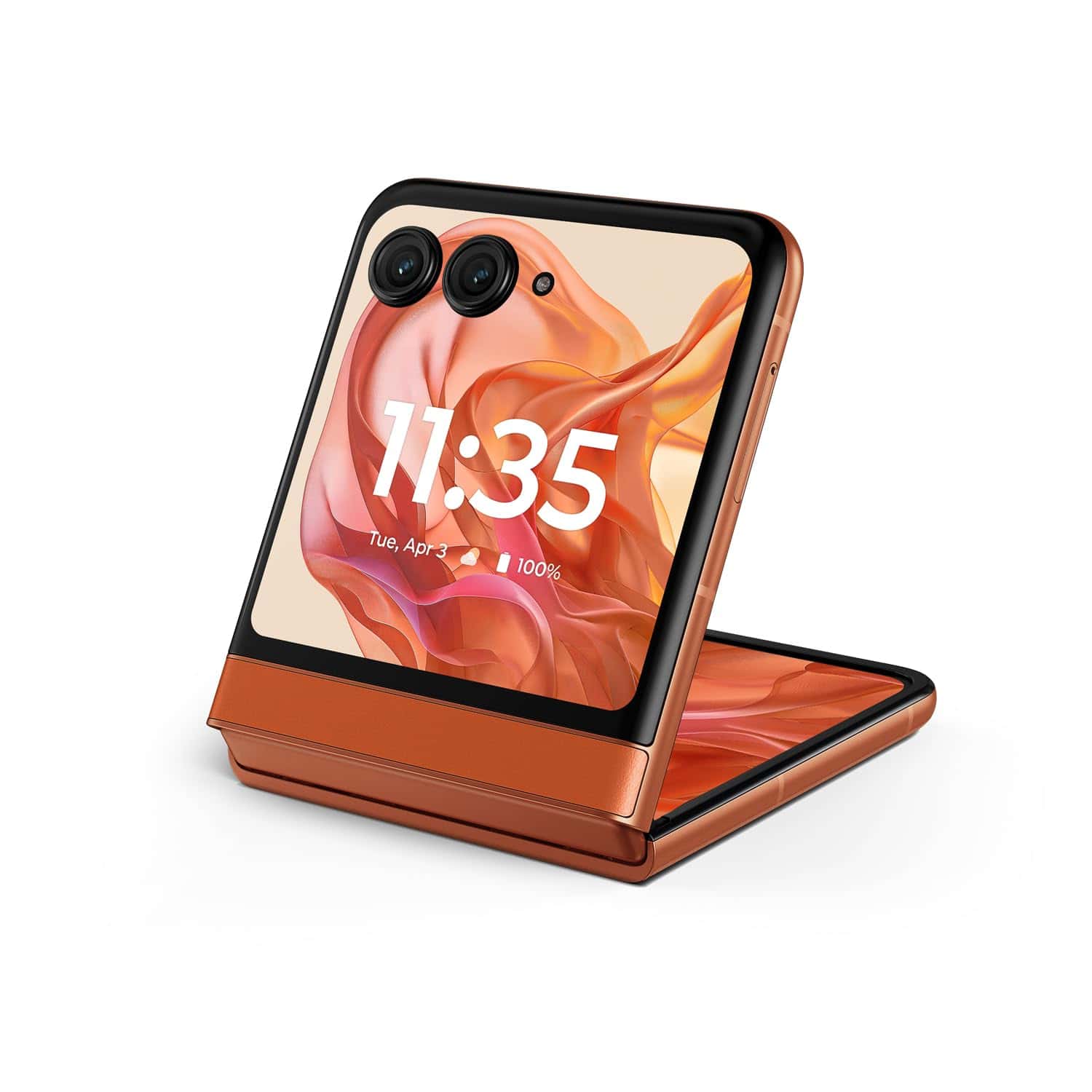Both Motorola and Samsung are leading the modern flip foldable market. While Samsung has refined its Galaxy Z Flip line over several generations, Motorola’s Razr series has been catching up quickly, especially with its latest Razr 2025 and Razr Ultra 2025 models.
Design & Build
- Motorola Razr (2025)
- Larger external cover display (great for notifications, apps, and selfies).
- Slimmer hinge with less visible crease.
- Premium vegan leather or glass finishes depending on model.
- Samsung Galaxy Z Flip 6/7
- Smaller cover display (though Samsung has expanded it since the Z Flip 5).
- More compact and polished hinge design.
- Wide range of colors and customization options.
👉 If you want a bigger outer screen, the Razr wins. If you want sleek refinement, Samsung takes the lead.

Displays
- Razr 2025 Ultra:
- Inner: 6.9″ LTPO AMOLED, 165Hz refresh rate, HDR10+.
- Outer: 4″ AMOLED (largest in its class).
- Galaxy Z Flip 7:
- Inner: 6.7″ AMOLED, 120Hz refresh rate.
- Outer: 3.4″ AMOLED (smaller than Razr’s).
👉 Motorola gives you a bigger, smoother display experience, especially on the outside.
Cameras
- Razr 2025 Ultra:
- Dual 50MP sensors (main + ultrawide).
- Strong low-light performance.
- Better selfie experience using the big cover screen.
- Galaxy Z Flip 7:
- Dual 12MP sensors (main + ultrawide).
- Improved AI image processing.
- Reliable but not as advanced as Motorola’s optics.
👉 Motorola has the better hardware, while Samsung leans on software & AI enhancements.
⚡ Performance & Battery
- Razr 2025 Ultra:
- Snapdragon 8 Gen 4.
- 4500mAh battery with 68W wired fast charging + 15W wireless.
- Galaxy Z Flip 7:
- Snapdragon 8 Gen 4 (same chip).
- 4000mAh battery with 25W wired charging + 15W wireless.
👉 Motorola wins on battery size and charging speed.
Software & AI
- Samsung Z Flip:
- Runs One UI 7 (Android 15).
- Deep Galaxy AI integration (translation, photo editing, productivity tools).
- 7 years of OS updates.
- Motorola Razr 2025:
- Runs near-stock Android 15.
- Motorola’s “Moto AI” features (summarization, voice assistance).
- 4 years of OS updates.
👉 Samsung wins in long-term support and AI ecosystem.
💰 Price & Value
- Motorola Razr 2025 Ultra: ~$999–$1099.
- Samsung Galaxy Z Flip 7: ~$999.
👉 Both are premium, but Samsung offers better long-term value due to updates, while Motorola gives you better hardware for the same price.
Which Should You Buy?
- Choose Motorola Razr (2025) if you want:
- Bigger external display.
- Better cameras.
- Faster charging & larger battery.
- Choose Samsung Galaxy Z Flip 7 if you want:
- Longest software support.
- Polished ecosystem (pairs great with Galaxy Watch, Buds, Tablets).
- Sleeker design refinements.
👉 In short: Motorola Razr 2025 is the better hardware phone, while Samsung Z Flip 7 is the better ecosystem phone.
Motorola Razr vs Samsung Galaxy Z Flip 4
When it comes to choosing a foldable phone, consumers often compare the Motorola Razr and the Samsung Galaxy Z Flip 4. Both devices offer a blend of modern specs and nostalgic design, attracting users who are looking for the latest features in a foldable format. The Razr, with its iconic name and refined design, goes head to head against the Galaxy Z Flip 4, which comes from Samsung’s well-established Galaxy lineup.
The Motorola Razr and Samsung Galaxy Z Flip 4 showcase different approaches to the foldable phone concept. The Razr banks on its legacy, bringing a familiar flip design with updated internals, while the Galaxy Z Flip 4 aims to offer seamless performance with flagship-grade specifications. Both phones target a similar market yet offer unique experiences through their individual design philosophies and display technologies.
Key Takeaways
- The Motorola Razr and Samsung Galaxy Z Flip 4 are leading choices in the foldable phone category.
- Each phone presents a distinct design and display quality that appeals to various preferences.
- Spec comparisons indicate that both phones strive to offer high performance and useful features.
Design and Display Comparison
When comparing Motorola Razr and Samsung Galaxy Z Flip 4, the design and display each carry distinguishing features. The build materials, display technology, and unique form factor contribute to the user experience. Here we look at how they differ.
Build Quality and Durability
The Galaxy Z Flip 4 features Gorilla Glass Victus which is known for its durability. This phone is also water-resistant with an IPX8 rating. It can withstand being submerged in water at a specified depth. Motorola’s Razr counters with a build protected by a water-repellent design, although it has an IP52 rating. This means it can handle some dust and dripping water but isn’t as sturdy against submersion like the Z Flip 4.
Display Technology
Samsung uses a Dynamic AMOLED display for the Z Flip 4. The term “Dynamic” relates to the screen’s ability to provide a high dynamic range with vivid colors and deep blacks. On the other hand, Motorola equips the Razr with a POLED, or plastic OLED, display. This material allows for a flexible screen which is essential for foldable phones.
Form Factor
Both the Samsung Galaxy Z Flip 4 and the Motorola Razr showcase a clamshell design. This means they fold in half to become more compact. The Galaxy Z Flip 4 unfolds to feature a screen aspect ratio suited for typical smartphone use. The Razr also follows the clamshell style with an emphasis on a thin and sleek look when unfolded.
Display Features
The Z Flip 4 outshines with its display features. It boasts a high refresh rate for smoother scrolling, which is set at 120Hz. The display resolution contributes to the overall sharpness of the screen, offering FHD+ quality. Motorola’s Razr also has its merits with a capable refresh rate and resolution that ensure clarity and responsiveness. The display brightness is measured in nits, where both phones provide adequate brightness for visibility in most lighting conditions.







